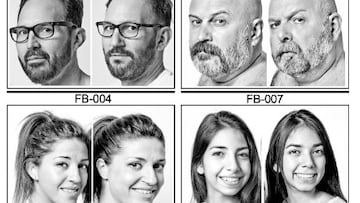Why do they look like me? This is the doppelgänger explanation
A study has concluded that the resemblance may go beyond the physical and suggests that both people also behave in a similar way.

Have you ever been walking down the street and somebody speaks to you as if they really know you? If so, and it happens more than you may think, then most likely you have a doppelgänger -- a biologically unrelated look-alike -- in the near vicinity, and scientists have been looking into the phenomenon.
Sharing doppelgänger DNA
Our face is one of the characteristics that most defines our identity and there are many faces that resemble each other. Usually this resemblance occurs between people from the same family: siblings, parents, grandparents, uncles, etc. But there are also strangers who have similar facial features and science is providing an answer to why this happens.
“What unites them most is their DNA sequence,” states one of the researchers, Manel Esteller, in the report published in Cell Reports. Although in order to understand this conclusion it is necessary to specify which elements related to DNA have been studied for the project. These have been the DNA sequences, which come from genetic inheritance (genome), a series of compounds that regulate the genome (the epigenomes) and the oral microbiomes of each person.
You may also enjoy reading:
- New ‘tomato flu’ virus spreads in India
- Northern Michigan dogs die in virus outbreak
- Natalia Vovk, the spy accused of assassinating Daria Dugina
The study indicates that a total of 19,277 elements (called nucleotides) that make up the genome affect the appearance of each one. And, according to the results, people who look a lot like each other physically “all have these same nucleotides,” Esteller explains.
The research has gone beyond the physical appearance and suggests that this resemblance may also extend to the behavior or habits of both people. “We saw that there is more genetic determination in whether they were more left-handed or right-handed, or in the ability to be addicted.”
Manel Esteller, the senior author of the study, told The Times that lookalike pairs also showed a similar tendency to be right or left-handed, to suffer from allergy-related conditions such as asthma, to be short- or normal-sighted, and to enjoy or avoid exercise
— Times Science (@TimesScience) August 23, 2022
Photographs used in lookalike study
The investigation has been carried out based on the images of the Canadian photographer François Bruenelle, who has been photographing people of remarkable physical resemblance who did not share kinship since 1991.
The images were submitted to different facial recognition programs in such a way that some algorithms confirmed the similarity. In addition, the 32 chosen couples had to provide a biological sample and be subjected to a series of questions about their habits.
A robot portrait from a DNA sample
Related stories
Esteller has indicated that, despite the limitations of this research — such as the fact that the images were in black and white and that the sample studied is small, among others — it may have future forensic implications. This is because, “from an unknown genome, you can start to create a face. And, in reverse, from the face we can also begin to deduce the genome.”
So, next time you see someone who looks very like you, and they’re not a close relative, just shout out: “Nice nucleotides!” I’m sure they’ll appreciate it.


